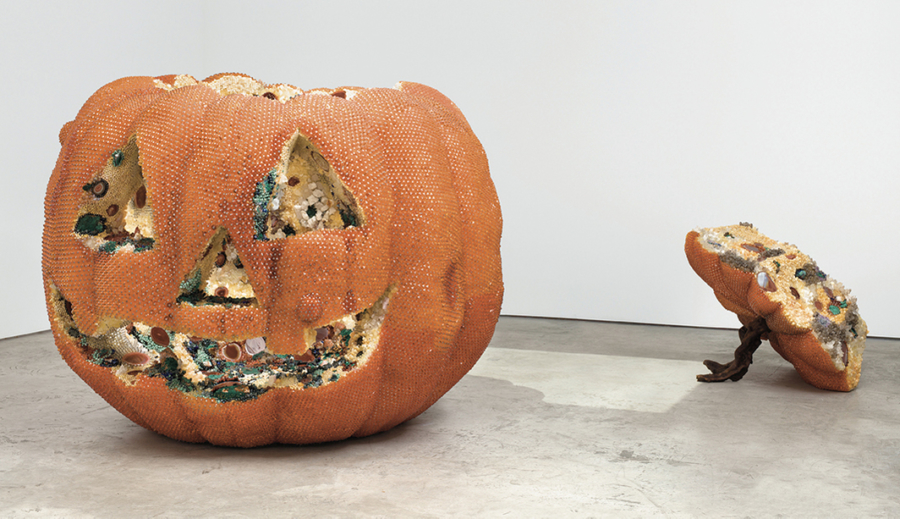September 2021
Download as PDF
View on Artforum

Kathleen Ryan, Jackie, 2021, azurite-malachite, lapis lazuli, agate, black onyx, brecciated jasper, moss agate, malachite, calcite, labradorite, rose quartz, smoky quartz, Ching Hai jade, red aventurine, carnelian, citrine, amethyst, quartz, acrylic, polystyrene, fiberglass, nails, steel pins, wood, 66 × 90 × 86”. From the series “Bad Fruit,” 2018–
When working inside the belly of the beast—say, within an art market fueled by extreme wealth and its cultural and political influence—artists, or anyone for that matter, inevitably think about survival, about matters of shelf life. Most of the works in Kathleen Ryan’s recent show at Karma were part of her “Bad Fruit” series, 2018–, exquisite oversize sculptures of overripe lemons and cherries meticulously fabricated from glass beads, crystals, and semiprecious stones. Hers is a triumph of trompe l’oeil decay, rot rendered as intricately and seductively as a piece of high jewelry. Bad Lemon (Sea Witch), 2020, looked to be the forgotten half of the citrus, now placed atop a pedestal and covered in multicolored mold signaled by the varying greens of serpentine, aventurine, turquoise, peridot, and moss agate; a luminous spectrum of mother-of-pearl, calcite, and moonstone; and other equally delectable materials. The fuzzy bottoms of Bad Cherries (Twins), 2021, are fashioned from freshwater pearls, rainbow moonstone, moss opal, rose quartz, and more. The show additionally featured fruits that were less gone, though none were presented as anything close to edible. All were on the wrong side of time, monumentalized by the artist before they could completely go to seed, to the pits—pun predetermined by Ryan, no doubt. All works in the show were gorgeous, funny to be sure, extending certain hallowed traditions in art, including those of seventeenth-century Dutch still lifes in which flowers drop their petals or fruit is left to the elements, embodying allegories aimed at the merchant class who would have hung them on their walls. The images are reminders that life is fleeting and that humans only prosper here on earth for a short time. Ryan’s work also points to Claes Oldenburg’s installation The Store, 1961, and his large-scale soft sculptures of food, with their saggy sad-sack presences, are meant to jab at America’s penchant for overconsumption.
Yet, despite the sculptures’ subject—decomposition, death—and the rebirth, the overthrow, it implies, their unmitigated glitz feels more Judith Lieber handbag than Trojan horse. Which isn’t to say that art made in, and for, the belly of the beast can’t be subversive. One of the great bombs lobbed from the art/rot axis was “9/4/1615,” fashion designer Martin Margiela’s ingenious 1997 retrospective at Rotterdam’s Museum Boijmans Van Beuningen, for which a selection of garments from the designer’s previous eighteen collections were remade and then sprayed with bright-yellow bacteria, pink yeast, and green mold that caused the clothes to slowly, brilliantly, decompose. Every piece in the exhibition looked like it had been exhumed and the skeleton shaken out of it, marking Margiela’s past with a very present musty smell. Even Damien Hirst’s market-driven memento mori For the Love of God, 2007, blew down the bounds of taste and money. His grinning skull was made of platinum, diamonds, and human teeth, which at least gave his work a little bite—pun predetermined by Hirst, no doubt. Ryan’s Jackie, 2021, the artist’s lightly macabre offering, smiles, too. This jack-o’-lantern is past its prime, its surface a still largely radiant orange, though its hollowed-out interior blooms in varying states of decay. It swipes at America, at Americana: What was once a day to recall the dead is now an occasion to boost candy sales, and these days corn syrup strikes more fear in the human heart than evil spirits do. Despite the works’ punch lines, as well as their conceptual and material contradictions, who or what is understood to be the allegorical rotting agent will depend on who controls the work’s context—at least inside our current political climate. Noting that dazzle isn’t traditionally an effect that enables much self-reflection, I left Ryan’s show longing for a sharper twist of her knife.


